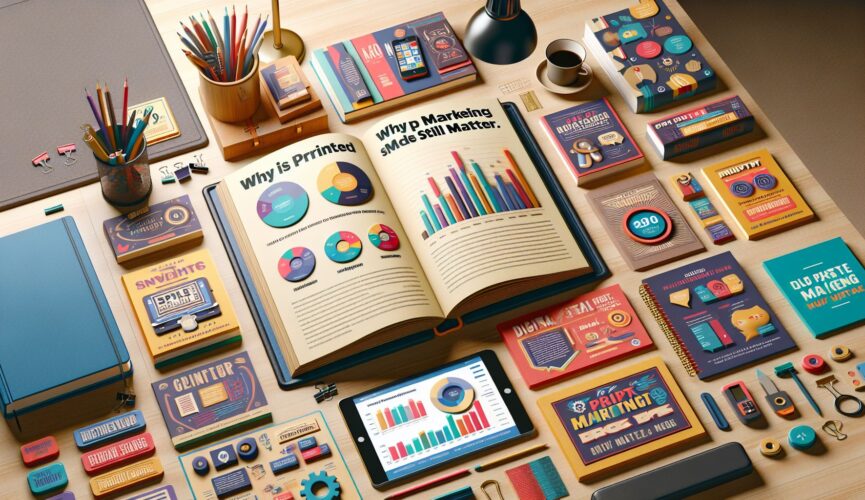Printed marketing materials have been an integral part of advertising campaigns for decades, providing businesses with a tangible way to connect with their target audience. In today’s digitally-dominated world, some may consider printed marketing materials outdated or even obsolete. However, the truth is that these traditional advertising tools still hold immense value and can significantly contribute to the success of a business.
Introduction
While digital marketing has undoubtedly revolutionized the way companies promote themselves, the importance of printed marketing materials cannot be ignored. From brochures and flyers to business cards and posters, these tangible assets have a unique ability to engage the audience, leaving a lasting impression that cannot be replicated by their digital counterparts. In this blog post, we will explore the reasons why printed marketing materials still matter and how businesses can leverage their power effectively.
The Tangible Connection
One of the key benefits of printed marketing materials is their ability to establish a tangible connection between businesses and their target audience. In a world where digital advertisements bombard us constantly, a physical printed piece stands out. Unlike fleeting online ads that can easily be scrolled past or ignored, a well-designed brochure or flyer captures attention and elicits a response. Furthermore, printed materials provide a sensory experience – people can feel the texture of the paper, see vibrant colors, and even catch a whiff of the ink. This multisensory approach plays a vital role in building a lasting connection with potential customers.
Credibility and Trust
In the digital age, online advertisements are often met with skepticism. Users are bombarded with pop-ups, banners, and sponsored content that can sometimes feel intrusive. Printed marketing materials, on the other hand, are often seen as more credible and trustworthy. A professionally printed brochure or a tastefully designed business card can convey a sense of legitimacy and reliability. These physical materials lend an air of authority to the company and can help build trust with potential customers, making them more likely to consider the business’s products or services.
Targeted Reach
Printed marketing materials offer a unique advantage when it comes to targeting specific demographics or geographical locations. For example, a local business looking to attract customers within a specific area can distribute flyers or postcards directly to mailboxes or hand them out at community events. This targeted approach allows businesses to reach their ideal customers directly and effectively—ensuring that their message is delivered to the right audience without being lost in a sea of digital noise.
A Lasting Impression
In today’s fast-paced digital world, information is consumed and forgotten in an instant. Printed marketing materials, however, have the ability to leave a lasting impression long after a digital ad has been scrolled past. A well-designed brochure or booklet can be kept on a coffee table or shared with others, ensuring that the message is repeatedly seen and absorbed. This extended exposure boosts brand recognition and keeps the business at the forefront of the customer’s mind when they are ready to make a purchasing decision.
Creative Freedom
Printed marketing materials offer businesses limitless creative freedom when it comes to design and format. Unlike digital ads, which often need to conform to specific dimensions or file sizes, printed materials can take various shapes, sizes, and finishes. This opens up a world of possibilities for businesses to create unique and visually appealing marketing assets that can stand out in a crowded marketplace. From embossed finishes to die-cut designs, businesses can use these creative elements to capture attention and differentiate themselves from competitors.
Building Brand Loyalty
Printed marketing materials play a crucial role in building and nurturing brand loyalty. By consistently using the same design elements, fonts, and color palette across all printed materials, businesses can reinforce their brand identity. This consistency helps customers recognize and remember the brand, fostering a sense of familiarity and trust. Moreover, when a business invests in high-quality printed materials, it conveys a commitment to professionalism and attention to detail, which further strengthens the bond between the brand and its customers.
Measurable Impact
While digital marketing offers robust tracking capabilities, printed marketing materials can also be used to measure their impact effectively. By using unique QR codes or dedicated phone numbers on printed ads, businesses can track the response rate and evaluate the effectiveness of their campaigns. This data provides valuable insights into customer engagement and helps businesses refine their marketing strategies for optimal results. Furthermore, consumer surveys can be used to gather feedback about the printed materials, allowing businesses to fine-tune their designs and messaging based on real-world responses.
Sustainability Considerations
As businesses become increasingly conscious of their environmental impact, it’s essential to address the sustainability aspect of printed marketing materials. While it is true that producing printed materials requires paper and ink, advancements in Printing technology have made significant strides towards eco-friendliness. Companies can adopt sustainable practices by using recycled paper, soy or vegetable-based inks, and partnering with printers with environmentally friendly certifications. Additionally, businesses can promote responsible disposal or recycling of their printed materials to minimize their carbon footprint.
Conclusion
Despite the ever-expanding digital landscape, printed marketing materials continue to play a vital role in contemporary advertising campaigns. By harnessing their tangible connection, credibility, targetability, and creative freedom, businesses can create a lasting impression and build brand loyalty. Moreover, with effective tracking and sustainable practices, printed materials can align seamlessly with a company’s overall marketing strategy. In a world where digital noise often dominates, the power of printed marketing materials should not be underestimated. So, the next time you plan your marketing efforts, consider the immense value that printed materials bring to the table.

